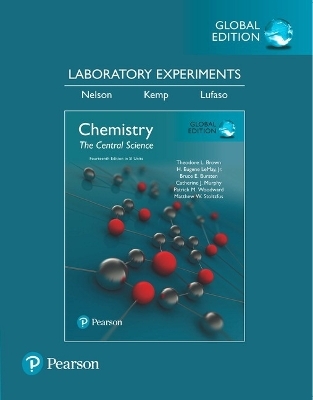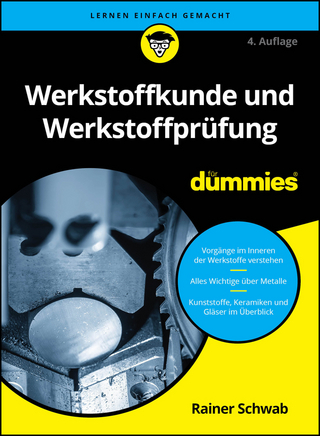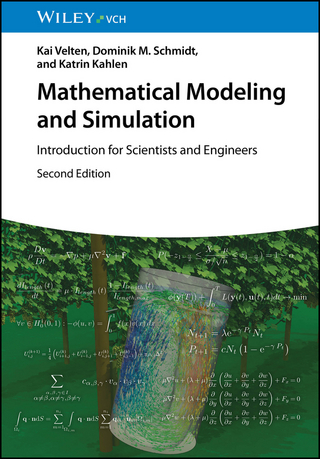
Laboratory Experiments for Chemistry: The Central Science in SI Units
Pearson Education Limited (Verlag)
978-1-292-22133-5 (ISBN)
Prepared by John H. Nelson and Kenneth C. Kemp, both of the University of Nevada, this manual contains 43 finely tuned experiments chosen to introduce students to basic lab techniques and to illustrate core chemical principles. In the 14th Edition, all experiments were carefully edited for accuracy, safety, and cost. Pre-labs and questions were revised and new experiments added concerning solutions, polymers, and hydrates.
Each of the experiments is self-contained, with sufficient background material, enabling students to conduct and understand the experiment. Each has a pedagogical objective to exemplify one or more specific principles. Because the experiments are self-contained, they may be undertaken in any order, although the authors have found in their General Chemistry course that the sequence of Experiments 1 through 7 provides the firmest background and introduction. To assist the student, the authors have included pre-lab questions for the student to answer before starting the lab. The questions are designed to help the student understand the experiment, to learn how to do the necessary calculations to treat their data, and as an incentive to read the experiment in advance.
THEODORE L. BROWN received his Ph.D. from Michigan State University in 1956. Since then, he has been a member of the faculty of the University of Illinois, Urbana-Champaign, where he is now Professor of Chemistry, Emeritus. He served as Vice Chancellor for Research, and Dean of The Graduate College, from 1980 to 1986, and as Founding Director of the Arnold and Mabel Beckman Institute for Advanced Science and Technology from 1987 to 1993. Professor Brown has been an Alfred P. Sloan Foundation Research Fellow and has been awarded a Guggenheim Fellowship. In 1972 he was awarded the American Chemical Society Award for Research in Inorganic Chemistry and received the American Chemical Society Award for Distinguished Service in the Advancement of Inorganic Chemistry in 1993. He has been elected a Fellow of the American Association for the Advancement of Science, the American Academy of Arts and Sciences, and the American Chemical Society. H. EUGENE LEMAY, JR., received his B.S. degree in Chemistry from Pacific Lutheran University (Washington) and his Ph.D. in Chemistry in 1966 from the University of Illinois, Urbana-Champaign. He then joined the faculty of the University of Nevada, Reno, where he is currently Professor of Chemistry, Emeritus. He has enjoyed Visiting Professorships at the University of North Carolina at Chapel Hill, at the University College of Wales in Great Britain, and at the University of California, Los Angeles. Professor LeMay is a popular and effective teacher, who has taught thousands of students during more than 40 years of university teaching. Known for the clarity of his lectures and his sense of humor, he has received several teaching awards, including the University Distinguished Teacher of the Year Award (1991) and the first Regents’ Teaching Award given by the State of Nevada Board of Regents (1997). BRUCE E. BURSTEN received his Ph.D. in Chemistry from the University of Wisconsin in 1978. After two years as a National Science Foundation Postdoctoral Fellow at Texas A&M University, he joined the faculty of The Ohio State University, where he rose to the rank of Distinguished University Professor. In 2005, he moved to the University of Tennessee, Knoxville, as Distinguished Professor of Chemistry and Dean of the College of Arts and Sciences. Professor Bursten has been a Camille and Henry Dreyfus Foundation Teacher-Scholar and an Alfred P. Sloan Foundation Research Fellow, and he is a Fellow of both the American Association for the Advancement of Science and the American Chemical Society. At Ohio State he has received the University Distinguished Teaching Award in 1982 and 1996, the Arts and Sciences Student Council Outstanding Teaching Award in 1984, and the University Distinguished Scholar Award in 1990. He received the Spiers Memorial Prize and Medal of the Royal Society of Chemistry in 2003, and the Morley Medal of the Cleveland Section of the American Chemical Society in 2005. He was President of the American Chemical Society for 2008. In addition to his teaching and service activities, Professor Bursten’s research program focuses on compounds of the transition-metal and actinide elements. CATHERINE J. MURPHY received two B.S. degrees, one in Chemistry and one in Biochemistry, from the University of Illinois, Urbana-Champaign, in 1986. She received her Ph.D. in Chemistry from the University of Wisconsin in 1990. She was a National Science Foundation and National Institutes of Health Postdoctoral Fellow at the California Institute of Technology from 1990 to 1993. In 1993, she joined the faculty of the University of South Carolina, Columbia, becoming the Guy F. Lipscomb Professor of Chemistry in 2003. In 2009 she moved to the University of Illinois, Urbana-Champaign, as the Peter C. and Gretchen Miller Markunas Professor of Chemistry. Professor Murphy has been honored for both research and teaching
1. Introduction: Matter, Energy, and Measurement
2. Atoms, Molecules, and Ions
3. Chemical Reactions and Reaction Stoichiometry
4. Reactions in Aqueous Solution
5. Thermochemistry
6. Electronic Structure of Atoms
7. Periodic Properties of the Elements
8. Basic Concepts of Chemical Bonding
9. Molecular Geometry and Bonding Theories
10. Gases
11. Liquids and Intermolecular Forces
12. Solids and Modern Materials
13. Properties of Solutions
14. Chemical Kinetics
15. Chemical Equilibrium
16. Acid—Base Equilibria
17. Additional Aspects of Aqueous Equilibria
18. Chemistry of the Environment
19. Chemical Thermodynamics
20. Electrochemistry
21. Nuclear Chemistry
22. Chemistry of the Nonmetals
23. Transition Metals and Coordination Chemistry
24. The Chemistry of Life: Organic and Biological Chemistry
Appendices
Mathematical Operations
Properties of Water
Thermodynamic Quantities for Selected Substances
Aqueous Equilibrium Constants
Standard Reduction Potentials
Answers to Selected Exercises
Answers to Give It Some Thought
Answers to Go Figure
Answer to Selected Practice Exercises
Glossary
| Erscheinungsdatum | 14.07.2018 |
|---|---|
| Verlagsort | Harlow |
| Sprache | englisch |
| Maße | 215 x 275 mm |
| Gewicht | 1740 g |
| Themenwelt | Schulbuch / Wörterbuch |
| Naturwissenschaften ► Chemie | |
| ISBN-10 | 1-292-22133-X / 129222133X |
| ISBN-13 | 978-1-292-22133-5 / 9781292221335 |
| Zustand | Neuware |
| Haben Sie eine Frage zum Produkt? |
aus dem Bereich


